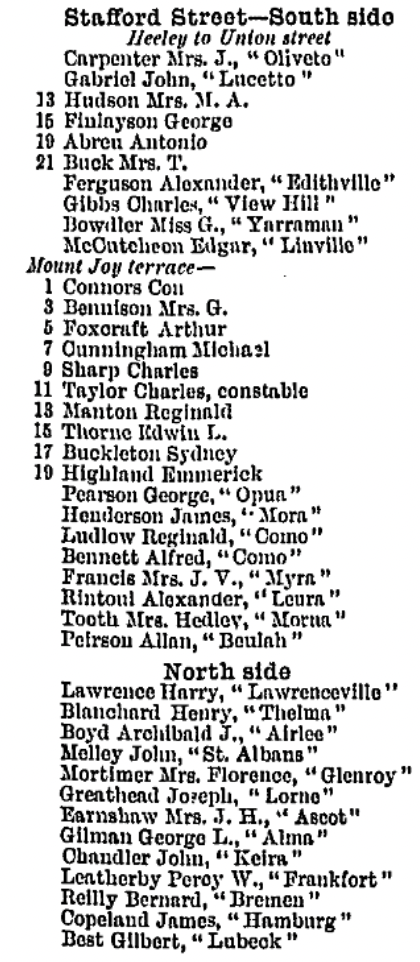The Terrace Detective: Stafford St
Stafford St, circa 1970
What’s in a (heritage house) name?
One of the things I love about Paddington is the collection of heritage houses and the sense of history this gives the suburb. A few years ago, our terrace on Cambridge St was featured in an ABC documentary series, Who’s Been Sleeping In My House (Season 2, Episode 3, if you can find it).
Apart from learning a lot about my own house, a great part about participating in the program was learning how the professional historians did their investigations.
Local history has been an interest of mine since then, doing bits of research here and there for friends. Which is how I have come to be writing this column. Speaking to the editor recently, she mentioned she was interested in knowing if her terrace had a name. I was only too happy to find out, and this will be the first case for The Terrace Detective.
Now, not every terrace has its own name. Some certainly do, with the names immortalised in the façade; examples include ‘Isis’, ‘Mona’ and ‘Clio' between 7 and 11 Heeley St.
During the early days of Paddington’s development, it was often unclear how many houses were going to be built on a street. House names were therefore invaluable for working out who lived where before the street numbers were allocated. Names were also used to help personalise houses which were often built in groups.
Stafford St today. Picture: Trent van der Jagt
The scene for our first case is the south-east corner of Stafford St, encompassing numbers 51 to 83. If you take a walk along this part of the street you can tell just from looking at the terraces that there are two distinct groups: one group of 10 terraces from 51 to 69 Stafford and another group of seven terraces from 71 to 83 Stafford.
The beauty of Stafford St from a local historian’s perspective is that it is relatively short. This means it is unlikely to have been renumbered over the years, as happened to some longer streets (Glenmore Rd, I’m looking at you).
A keen observer will also note that 79 Stafford has the name ‘Leura' painted in glass under the balcony railing. Most of the time a name on a house will be the original name but it will be great to see if we can prove this through research.
To work this case, I’m going to first introduce you to one of the key pieces of the Paddington historian’s toolkit: the Sands Postal Directory.
Except from the Sands Directory
The Sands Directory is like the White Pages phone book before there were phones. Published by John Sands Ltd as the Sydney, Suburban and County Commercial Directory from 1858 to 1933, this massive book lists suburbs alphabetically, and then within each suburb lists streets (again alphabetically) and then finally, it lists the residents of each side of the street geographically from one end to the other.
When I started out with this hobby you would need to trek into the State Library to access the Sands Directory on microfiche. Nowadays you can search the directory from the comfort of home via the City of Sydney online archives.
From my experience with Cambridge St, which was developed in the late 1880s, I decided to try my luck and dive straight into the Sands 1891 Directory. This drew a blank, not just for my subject row of terraces but for the whole street. There was no Stafford St listed at all.
Some additional preparatory research was required. It turns out that Stafford St was created from one of the later Paddington subdivisions, that of the Bradley Hall estate. The colonial Georgian house was built in 1845 by the one-time mayor of Sydney, Thomas Stafford Broughton, until its demolition in 1898, after which Broughton’s eight acres were subdivided.
Broughton died in 1901, at the age of 89, and his estate was subdivided in the early 1900s. The sandstone garden boundary wall that runs behind the houses on Stafford St is thought to be the only surviving remnant of Bradley Hall.
(As a brief aside, those who know Glenmore Road Public School may recognise this name. Each sporting house at the primary school draws its inspiration from one of the colonial houses of Paddington and Bradley is the blue team.)
With this updated background information I then went back and started with later Sands editions. This takes a bit longer but does make it easier to catch anomalies such as street renumbering and new houses being built.
Looking at the 1928 Sands Directory, we find the southern side of the street listed, with the last house at 83, but no names. All good, the listing matches what is currently there. Moving earlier, year by year, we get a sprinkling of names, but by 1908 we hit the jackpot — virtually every house listed has both a number and a name. The 1905 listing has no street numbers but every house has a name.
The Terrace Detective has just closed his first case.
The group of terrace houses from 51 to 69 Stafford were originally the ‘Mount Joy’ terraces (each individually numbered 1 through 19). For the group of terraces from 71 to 83 we have the following names: ‘Opua’ at 71, ‘Mora’ at 73, ‘Como’ at 75, ‘Myra’ at 77, ‘Leura’ at 79, ‘Morna’ at 81 and ‘Beulah’ at 83.
For future cases I hope to showcase some other local history sources: the Paddington Rate books kept at the Woollahra Council local history centre, the Trove archive maintained by the National Library of Australia and let’s not forget good old Dr Google.



